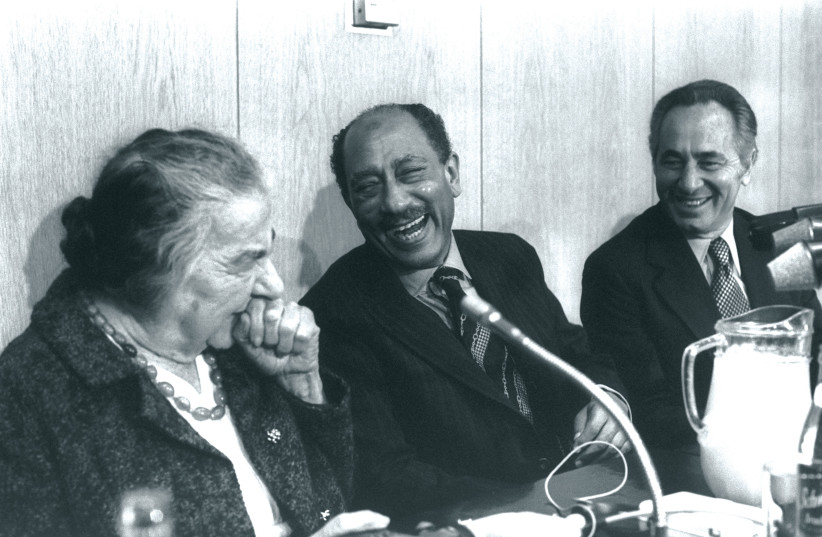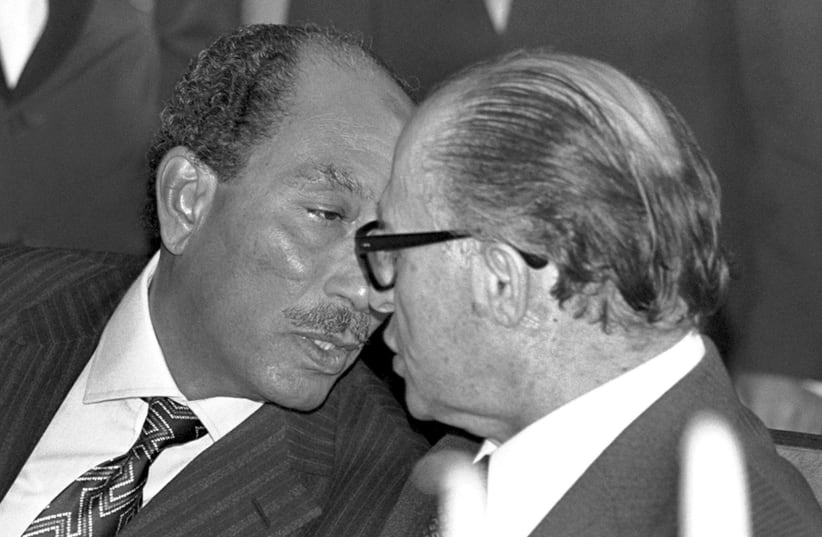When Egyptian president Anwar Sadat touched down at Ben-Gurion Airport on November 19, 1977 the whole world was watching. His visit to Israel, the first of its kind by an Arab head of state, was a game-changer: A harbinger of what Shimon Peres would later call “the new Middle East.”
Sadat’s arrival mesmerized Israel. Thousands of awestruck Israelis lined the route of his motorcade to catch a glimpse of the man who, just four years earlier, had been their sworn enemy. Those not gathering in the streets were glued to their television screens, ecstatically following the wall-to-wall coverage.
The public euphoria would eventually dissipate, but for the duration of Sadat’s trip, Israelis were enchanted – the leader of the most powerful and populous Arab state had come to make peace.
Ten days earlier, on November 9, Sadat had addressed a special session of the People’s Assembly in Cairo. There, while reiterating his previously professed desire for peace, the Egyptian president unexpectedly expressed a readiness to travel to the Knesset in Jerusalem to expedite talks.
Sadat received the usual standing ovation befitting the conclusion of a speech by a Middle Eastern autocrat. Even PLO leader, Yasser Arafat, one of the honored foreigners attending the session, rose from his chair and applauded, perhaps not appreciating that a rigid taboo had just been broken – an Arab leader was suggesting direct engagement with his Israeli counterpart.
In Jerusalem, the importance of Sadat’s offer was readily appreciated. Prime minister Menachem Begin expeditiously invited the Egyptian president to Israel, despite the formal state of war between the two countries.


Begin: More eager for peace than Americans thought
Begin, after decades on the opposition benches, had become premier in June 1977. Many viewed him as a dangerous hawk; his first meeting with American president, Jimmy Carter, left the White House believing that Begin would have to be pressured if there were to be any movement on peace in the Middle East.
Yet Begin was more eager than the Americans realized. In August 1977, he flew to Bucharest to ask Romanian communist strongman, Nicolae Ceauşescu, to convey a message to Sadat that Israel was serious about a deal.
Subsequently, Begin’s foreign minister, Moshe Dayan, flew to Morocco for secret talks with Egypt’s deputy prime minister Hassan Tuhami – from which the Egyptians understood that Jerusalem would be flexible on the all-important territorial question.
INTERESTINGLY, THE Romanian and Moroccan tracks eclipsed Washington’s normally hegemonic diplomacy. Carter entered the White House in January 1977, determined to advance a comprehensive Middle East peace. He saw the incremental steps orchestrated by Henry Kissinger under presidents Richard Nixon and Gerald Ford as overly piecemeal. Instead, Carter sought an international peace conference in Geneva, bringing together the United States, Soviet Union, Israel, the Arab states and the Palestinians, that would solve the Arab-Israel conflict once and for all.
Sadat understood that these American proposals were a prescription for continued stalemate. Such a multilateral forum would subjugate progress to the whims of its most rejectionist participants, the Syrians and Palestinians.
Aiming to circumvent ideas that would constrain Egypt’s freedom of action, Sadat embraced Begin’s Romanian-Moroccan feelers, stunning the world by proposing high-level, face-to-face talks.
It was not the first time Sadat had played the disrupter. In October 1973, he launched the Yom Kippur War, a coordinated Egyptian-Syrian surprise attack on Israel. Up to that point, many belittled Sadat, seeing him as a mere shadow of his charismatic predecessor, Gamal Abdel Nasser who had enthralled the Middle East with his revolutionary, pan-Arab nationalism. But Sadat outsmarted his detractors, proving himself to be a bold strategist and astute tactician.
The Yom Kippur War
The Yom Kippur War reestablished Arab pride, saw Cairo move from Soviet client to American ally, and led to two Egypt-Israel breakthroughs: the Sinai I Disengagement of Forces Agreement of January 1974 and the Sinai II Interim Agreement of September 1975.
Thus, when Sadat announced his willingness to visit Israel, he did so from a position of enhanced domestic and international strength, and with preliminary steps toward peace already behind him.
Sadat’s initiative created a dilemma for Israel. Since the 1967 Six Day War, Israel’s governments had called for direct negotiations leading to genuine and enduring peace. Sadat gave them the former and promised the latter, while, at the same time, demanding a “complete withdrawal from the Arab territories occupied after 1967” including “Arab Jerusalem.”
This challenged the most basic Israeli precepts. For real peace, Israel’s governments had stated a readiness for territorial compromise, yet they underlined the need for secure borders that would necessitate changes to the pre-1967 lines. Here was an Arab leader offering full peace, contingent upon full withdrawal.
As America’s new friend, Sadat could say to Washington that he had taken a dramatic step towards peace, and it was now incumbent upon Israel to respond with an equally significant move. But Begin’s reciprocal visit to Egypt in December 1977 failed to deliver a commensurate development.
Carter was initially critical of Sadat’s Jerusalem overture, correctly fearing that it would destroy American plans for a Geneva conference. However, seeing the bilateral negotiations deadlocked, Carter decided that the United States had to help the parties bridge their gaps. Thereafter, a massive American diplomatic effort followed, with Carter devoting countless valuable presidential hours to the peace talks.
Ultimately, Carter’s indefatigable personal involvement bore fruit. The Camp David Accords were signed in September 1978 and the Egypt-Israel peace treaty finalized by March 1979.
In the end, Sadat could claim he got a full Israeli withdrawal from occupied Egyptian territory, with the evacuation of the Sinai Peninsula in its entirety – all of Israel’s Sinai settlements were dismantled.
The Gaza Strip was a different matter. Ruled by Egypt from 1948 to 1967, it had never been sovereign Egyptian territory. At Camp David it was decided that Gaza, along with the West Bank, would be dealt with separately, first in the arrangements for Palestinian autonomy and later in final status talks.
While Begin justifiably deserves praise for achieving peace, his attitude toward Gaza may have been his biggest misstep. Had he insisted that Sadat’s demand for a full withdrawal apply to the strip, keeping the Israeli-Gaza frontier quiet would have become an Egyptian peace treaty obligation.
Since prime minister Ariel Sharon’s 2005 disengagement, Israel has fought five wars in Gaza. One cannot help but wonder whether they could have been avoided had the strip not been evacuated unilaterally, but returned to Egypt four decades ago as part of an agreement.
The writer, formerly an adviser to the prime minister, is chair of the Abba Eban Institute for Diplomacy at Reichman University. Follow him at @AmbassadorMarkRegev on Facebook.
